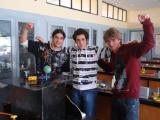Archivo de noticias y eventos
1601 - 1650 de un total de 2405
También puede acceder a la lista de noticias publicadas en los medios relacionadas con el Instituto de Astrofísica de Andalucía - CSIC.
Pages

|
04/12/2009
Una tarde de astronomía Made in Spain El próximo miércoles 9 de diciembre se celebrará, en el salón de actos del Instituto de Astrofísica de Andalucía (IAA-CSIC), un pequeño maratón astronómico dentro del programa “Astronomía made in Spain”. |

|
03/12/2009 - 13:00
Tracing dust at the edge of destruction: NIR observations of YSO transitional disks and nearby AGN with the Keck interferometer After a short introduction to modern infrared long baseline interferometry, I will present the results of two actual projects of mine, dealing with dust around stars and AGN. Based on observations with the Keck interferometer, we could show that the infrared-excess in transitional YSO class II disks typically derives from circumstellar disk material, and not from a close companion star. Disk dissipation induced by planet formation now appears to... Jörg-Uwe Pott |

|
30/11/2009
Concurso "LUCAS LARA-MANUEL ATIENZA" Dentro de las actividades organizadas por el Instituto de Astrofísica de Andalucía (IAA, CSIC) para el "Año Internacional de la Astronomía – AIA2009", el IAA convoca un concurso dirigido a alumnos de tercer y cuarto curso de Secundaria. |

|
26/11/2009 - 13:00
GROND: A multi-channel imager on La Silla GROND stands for Gamma-Ray Burst Optical/Near-Infrared Detector. It is a 7-channel imager developed by the Max-Planck-Institut for extraterrestrial Physics in Garching, Germany, with contributions from the Thueringer Landessternwarte Tautenburg, Germany. GROND is mounted at the 2.2m telescope on La Silla since mid 2007. A short overview is given about the instrument, its operation, and its scientific achievements. Sylvio Klose |

|
24/11/2009 - 26/11/2009
OSIRIS (ROSETTA, ESA) Full Team Meeting 2009 Granada |

|
19/11/2009 - 13:00
CARMENES, a next-generation instrument for the CAHA 3.5-m telescope CARMENES is a study for a next-generation instrument for the 3.5m telescope at the Calar Alto Observatory that will be built by an international consortium. CARMENES stands for Calar Alto high-Resolution search for M dwarfs with Exo-Earths with a Near-infrared Echelle Spectrograph. Since M dwarfs have low effective temperatures (Teff < 4000 K), our spectrograph is designed to operate in the optical red and the near infrared, where they emit... Pedro J. Amado |

|
12/11/2009 - 13:00
An extremely prolific supernova factory in the buried nucleus of a starburst galaxy Tbd Miguel Ángel Pérez Torres |

|
11/11/2009 - 16:00
Científicos y periodistas, ¿condenados a entenderse? Avanzamos hacia sociedades basadas en el conocimiento, donde el público demanda mayor y mejor información científico-técnica. Entre los obstáculos para la difusión de una información científica de calidad se encuentra la falta de entendimiento entre la propia fuente de información -por lo general, los científicos- y los llamados ‘traductores’ del mensaje -los... María Teresa Bermúdez Villaescusa(IAA-CSIC) Sala de Juntas del Instituto de Astrofísica de Andalucía (IAA-CSIC) |

|
05/11/2009 - 13:00
ESO: a brief overview Based on talks presented at the "Jornada ESO 2009", held on 22 September 2009, I will provide a brief overview of some statistical data related to ESO and particularly the role of Spain within ESO. I will also provide a brief overview of the current status of ESO telescopes and available instruments as well as upcoming developments, like ALMA/E-ELT. Rainer Schoedel |

|
29/10/2009 - 13:00
PANIC: current status We will present the current status of the PANIC project. This instrument will be the first to be built inside the Spanish-German consortium signed between MPIA and IAA for the development of new instrumentation for the Calar Alto Observatory. PANIC is a wide-field infrared imager for the Ritchey-Chrétien focus of the Calar Alto 2.2m and 3.5m telescopes. The camera optical design is a folded single optical train that images the sky onto the focal... Matilde Fernández, Julio F. Rodríguez, Conchi Cárdenas y José M. Ibáñez |

|
27/10/2009 - 28/10/2009
Primer Curso Práctico de la Red Temática SVO Granada |

|
22/10/2009 - 14:00
Light Scattering in the Solar System A concise survey of light scattering by small dust particles in the atmospheres and surface layers of various Solar System bodies, comets, the interplanetary medium, and in planetary rings is presented. Current issues and recent developments are emphasized. Special attention is given to experimental and numerical approaches for solving problems of light scattering by non-spherical dust particles. Key areas for further research are pointed out... Prof. J.W. Hovenier |

|
21/10/2009 - 10:00
Perturbaciones en las observaciones. Ruido en sismología estelar En cualquier observación intervienen factores no deseados que perturban las medidas y pueden falsear los datos. Puesto que el ruido constituye una barrera entre teoría y observación el conocimiento de las características del ruido que afecta a cada observación suele ser crucial en el trabajo de una buena parte de los astrofísicos. En esta charla se quiere dar una visión general del problema... Javier Pascual Granado (IAA-CSIC) Sala de Juntas del Instituto de Astrofísica de Andalucía (IAA-CSIC) |

|
15/10/2009 - 14:00
Las variables luminosas azules de la Gran Nube de Magallanes en acción: La evolución estelar masiva en tiempo real Las dos estrellas mas brillantes de la LMC en este momento son dos VLA en estado de erupción. Radcliffe 127 (R127) había sido una estrella de tipo Ofpe antes de 1980. En 1982 se descubrió que estaba entrando en una erupción de VLA, enseñándonos por primera vez la relación entre esos dos tipos de objetos peculiares. Estos eventos consisten en una expansión de la estrella y/o un eyección de una capa que reprocesa la luz ultravioleta hacia el rango... Nolan Walborn |

|
30/09/2009 - 10:00
Búsqueda de axiones mediante observaciones gamma de AGNs distantes Axion Like Particles (ALPs), postulated to solve the strong-CP problem in Particle Physics, may play a crucial role in the correct interpretation of gamma-ray astronomical observations as well as in the solution of the dark matter problem. They are predicted to couple with photons in the presence of magnetic fields, which may lead to a significant change in the observed spectra of gamma-ray sources such as AGNs. Indeed, this mechanism could... Miguel Ángel Sánchez-Conde (IAA-CSIC) Sala de Juntas del Instituto de Astrofísica de Andalucía (IAA-CSIC) |

|
24/09/2009 - 14:00
he central parsec of the Milky Way: shocks, outflows and young stars Both a dense stellar cluster and streamers of gas and dust coexist within the central parsec of the Milky Way Galaxy, in the deep potential well of the 4 million MSun black hole at the position of the radio source SgrA*. A number of features in the local interstellar medium (ISM) reveal that there is a great deal of interaction going on at the Galactic Center (GC), building up evidence for the existence of outflow(s) in the central 0.5 pc. The... Koraljka Muzic |

|
17/09/2009 - 14:00
Oscurecimiento en LINERs Tbd. Josefa Masegosa Gallego |

|
10/09/2009 - 14:00
8 meses del Año Internacional de la Astronomía 145 países participantes. En España, más de 2000 actividades ya celebradas y más de 1000 entidades participantes. Tras ocho meses de celebración, y gracias a la implicación de miles de personas, el Año Internacional de la Astronomía ha dado lugar a la mayor red de divulgación científica que ha existido nunca. Hablaré de la evolución que ha seguido esta conmemoración durante este periodo, las principales iniciativas que se han impulsado a nivel... Montserrat Villar Martín |

|
02/07/2009 - 14:00
Sunrise: una revisión previa a la ciencia En esta charla pretendo dar una visión global de la misión Sunrise, de sus propósitos científicos y de su desarrollo tecnológico. En particular me centraré en IMaX, el magnetógrafo solar en el cual ha participado con éxito el IAA (CSIC), tanto en su definición científica como siendo responsable de toda la electrónica y software del instrumento. Describiré aspectos del diseño y fabricación, así como presentaré abundante material gráfico de la... José Carlos del Toro Iniesta |

|
25/06/2009 - 14:00
Asteroids as the parent bodies of meteorites: compositional differences and size-dependent transport mechanisms Asteroids that come close to the Earth´s orbit (near-Earth asteroids, or NEAs) are targets of different sample-return space missions, providing us with material from their surfaces. Besides, we can also analyze the composition of meteorites in the laboratory, and run dynamical models that give us information about the source regions of NEAs and, consequently, the meteorites. By means of mineralogical analysis of their reflectance spectra,... Julia de León Cruz |

|
18/06/2009 - 14:00
25/20: The 25 greatest discoveries in astronomy and astrophysics of the 20th century I will present my personal list of the 25 most important and influential discoveries in astronomy of the 20th century. I will analyse the papers that reported these discoveries by the year they occurred, the age of the discoverers and the country where the people worked. The decades 1911-20 and 1960s were the most productive of the 20th century, in spite of the arrival of computers and observatories in space. I suggest reasons for the decline in... Prof. John Hearnshaw |

|
03/06/2009 - 15:00
'Las Páginas Amarillas de la e-Ciencia en Andalucía' ¿Puede un conjunto de herramientas servir para toda la comunidad científica Las páginas Amarillas de la e-Ciencia nacen como respuesta a una necesidad detectada por el proyecto de excelencia Creación de una infraestructura de e-Ciencia andaluza (e-Ca), dentro de la comunidad científica. En la sesión CCD de este miércoles, mostraremos el making off de estas nuevas páginas: Haremos un poco de historia sobre el proyecto; el contexto en el que surgen las Páginas Amarillas;... Ana Rejón y Susana Sánchez (IAA-CSIC) Salón de Actos del Instituto de Astrofísica de Andalucía (IAA-CSIC) |

|
21/05/2009 - 14:00
Comparing High and Low Redshift Quasar Properties: Black Hole Masses and Eddington Ratios Black hole mass and Eddington ratio estimates for quasars are of fundamental interest to astrophysicists and cosmologists. Comparisons of high and low redshift quasar properties are of special interest. Past comparisons have been unreliable because estimates are based upon measures of different emission lines in different redshift ranges. Are all broad emission lines valid virial estimators? Evidence suggests not motivating us to follow Hbeta... Jack Sulentic |

|
18/05/2009 - 21/05/2009
Workshop on Robotic Autonomous Observatories Málaga |

|
13/05/2009 - 10:00
ROSETTA OSIRIS y el fly-by con el asteroide STEINS: contribución del IAA en el análisis de las imágenes y overview del trabajo científico sobre los datos del fly-by El día 5 septiembre 2008 la misión ROSETTA alcanzó su primer objetivo: Steins, un asteroide de 5 km de diámetro en el cinturón principal de asteroides. El instrumento OSIRIS (Optical, Spectroscopic, and Infrared Remote Sensing System) ha tomado varias imágenes de este cuerpo menor, revelándonos detalles sobre su aspecto, su naturaleza y su historia. El IAA pertenece al grupo internacional de... Walter Sabolo (IAA-CSIC) Salón de Actos del Instituto de Astrofísica de Andalucía (IAA-CSIC) |

|
12/05/2009 - 15/05/2009
Galaxies in Isolation: Exploring Nature vs. Nurture Granada |

|
30/04/2009 - 14:00
PINGS: the PPAK IFS Nearby Galaxies Survey I will present the PPAK Integral Field Spectroscopy (IFS) Nearby Galaxies Survey: PINGS, a 2-dimensional spectroscopic mosaicking of 17 nearby disk galaxies in the optical wavelength range. This project represents the first attempt to obtain continuous coverage spectra of the whole surface of a galaxy in the nearby universe. The final data set comprises more than 44000 individual spectra, covering an observed area of nearly 80 arcmin squared.... F. Rosales-Ortega |

|
23/04/2009 - 14:00
CdC-SF: A precise proper motion catalogue from 'Carte du Ciel' plates, San Fernando Zone I will present an astrometric catalogue of positions and proper motions derived from the "Carte du Ciel" plates, San Fernando zone, which has a mean epoch 1901.4 and a limiting magnitude V~15. Digitization has been made using a conventional flatbed scanner. Special techniques have been developed to handle the combination of plate material and the large distortion introduced by the scanner. A variety of post-scan corrections are shown... Belén Vicente |

|
22/04/2009 - 15:00
Everything you wanted to know about Unidentified Infrared Bands (but did not dare to ask) Unidentified infrared bands (UIRs) are a family of bands that dominate the IR spectra of a wide variety of objects, including HII regions, PNe, post-AGB objects, YSOs the diffuse ISM, galaxies and galactic nuclei. Understanding these features and the origin and evolution of their carrier has become an important problem in astrophysics: thanks to ISO and Spitzer we now have a better insight of the problem, but still much work has to be done.... Alessandra Candian (University of Nottingham) Salón de Actos del Instituto de Astrofísica de Andalucía (IAA-CSIC) |

|
16/04/2009 - 14:00
Can we find Earth-mass planets orbiting our nearest star, alpha centauri? I will describe a new program at Mt John that aims to find Earth-mass planets orbiting either alpha Cen A or B, which are solar type stars in a well known binary. We are measuring precise radial velocities using the Hercules spectrograph, which I will describe. At least 10000 spectra at S/N ~ 500:1 giving 1 m/s precision will be needed. Theoretical studies show that Earth mass planets can have stable orbits to 3 AU and that such planets will... Prof. John B. Hearnshaw |

|
15/04/2009 - 10:00
ASTEROSEISMOLOGY: What, how and what for? What is Asteroseismology? What is it used for? How do we (asteroseismology scientists) work? These are the questions I want to answer in this talk. I will make a short introduction to variable stars and say some words about stellar interiors and the method generally used for the study of pulsations: the perturbative method. Finally, I will explain an example of how we work. I will make a travel from the moment of taking the data to the final... Antonio García Hernández Salón de Actos del Instituto de Astrofísica de Andalucía (IAA-CSIC) |

|
31/03/2009 - 14:00
Extended Emission Line Regions around radio-quiet QSOs It was noted soon after the discovery of the first quasars that some of them were surrounded by a nebulosity. Narrow-band imaging surveys and spectroscopic studies of quasars by Stockton et al. and Boroson et al. in the 1980s revealed that these nebulosities originated from extended emission-line regions (EELRs) where gaseous material is kept photoionized by the quasar. Since most of these quasars are radio-loud ones, it has been thought that... Bernd Husemann |

|
26/03/2009 - 13:00
Misión espacial Kepler. Planetas y Estrellas: Oferta 2x1 En los últimos años se han lanzado dos misiones espaciales CoRoT (CNES, ESA) y Kepler (NASA) que presentan objetivos científicos. Por un lado, buscar exoplanetas, i.e. planetas fuera del Sistema Solar, aquellos que se encuentran en la zona habitable (planetas en lo que pueda haber agua en estado líquido). Y por otro lado, observar estrellas para estudiar su estructura interna y evolución, haciendo uso de la Astrosismología. En esta charla... Juan Carlos Suárez |

|
19/03/2009 - 13:00
Spacetime and Noncommutative Geometry This talk, which is intended for non-specialists and makes particular emphasis on astrophysical/cosmological implications, will review the underlying physical motivations for the suggestions that spacetime is noncommutative. Causality violations are implied by such noncommutativity and that leads to physical effects. It also leads to Pauli principle violations and forbidden transitions, and to observable effects in CMB temperature spectrum.... A. P. Balachandran |

|
18/03/2009 - 11:00
Sistema fotométrico Alhambra: Caracterización, Calibración Fotométrica y Determinación de Puntos cero Introduciré un nuevo sistema fotométrico especialmente diseñado para realizar un estudio de la evolución cósmica del universo en una región discontinua de 4 grados cuadrados, el Sistema Fotométrico ALHAMBRA. El objetivo es el de caracterizar este sistema y generar una metodología que permita la calibración fotométrica de las magnitudes instrumentales del cartografiado.... Teresa Aparicio Villegas (IAA-CSIC) Salón de Actos del Instituto de Astrofísica de Andalucía (IAA-CSIC) |

|
12/03/2009 - 13:00
El Universo visto por las Astrónomas La Astronomía moderna no se puede concebir sin el trabajo realizado por todas aquellas mujeres que con su dedicación y amor a la ciencia nos han dejado su legado. A pesar de la práctica inexistencia de documentación bien estructurada sobre su papel en la historia de la Astronomía, los datos existentes muestran que ha existido un buen número de mujeres que con sus trabajo de investigación han contribuido a la concepción que hoy tenemos del... Josefa Masegosa Gallego |

|
11/03/2009 - 13:00
SpIOMM: An imaging Fourier transform spectrometer in the visible for astronomical observations Attached to the 1.6-meter telescope of the Observatoire du Mont Mégantic in southern Québec, SpIOMM is an imaging Fourier transform spectrometer designed to obtain the visible range (350 – 850 nm) spectrum of every astronomical light source in a circular field of view of 12 arcminutes in diameter. I will present some results of four recent successful observing runs, which highlight SpIOMM’s capabilities to map emission line objects... Gaetan Perron |

|
09/03/2009 - 10/03/2009
19th MIPAS Quality Working Group (QWG) Meeting Granada |

|
26/02/2009 - 13:00
Very High Energy Gamma-Ray Astrophysics with MAGIC The MAGIC-I telescope is currently the largest single-dish Imaging Atmospheric Cherenkov telescope in the world. A second telescope, MAGIC-II, will upgrade MAGIC-I in sensitivity, angular and spectral resolution from this year on. I shall describe the Cherenkov telescope detection technique, the astrophysical topics of interest in this brand new astronomical window and the results of the last four years of observation with the MAGIC telescope... Juan Cortina |

|
25/02/2009 - 11:00
Evolución y estructura de los Puntos Brillantes Coronales Los puntos brillantes coronales son pequeñas estructuras presentes durante todo el tiempo en la corona solar. Estos punto brillantes están asociados con la interacción de campos magnéticos presentes en la fotosfera. Aquí se presenta el estudio de varios puntos brillantes con distintos instrumentos cubriendo longitudes de ondas desde el óptico hasta los rayos-X. Con ello se analizan propiedades f... David Pérez-Suárez (Armagh Observatory & Queen's University Belfast) Sala de Juntas del Nuevo Edificio (IAA-CSIC) |

|
23/02/2009 - 26/02/2009
High-energy phenomena in Galaxy Clusters and Dark Matter Searches Granada |

|
19/02/2009 - 13:00
Panchromatic analysis of the star formation processes in M33 The spiral galaxy M33 belongs to the local group and allows us to study star formation processes with great accuracy. The Spitzer telescope reaches spatial resolutions of the order of some parsecs and reveals the interactions between young stars and the interstellar medium. A detail analysis focussed on the typical colours of discrete sources such as HII regions, planetary nebulae and supernovae remnants. Also, we estimated the star formation... Simon Verley |

|
11/02/2009 - 13/02/2009
Impact of ALMA on the Spanish Extragalactic Astronomy Granada |

|
29/01/2009 - 13:00
Charlas DEA / TIT En el camino hacia ALMA: técnicas de calibración de fase y gas molecular en grupos compactos de galaxias Vicent Martínez i Badenes (IAA-CSIC) En esta charla presentaré la preparación que llevo a cabo desde un punto de vista tanto científico como técnico de cara a ALMA. Las turbulencias en el vapor de agua en la troposfera producen decorrelación en la señal en los interferómetros milimétricos/submilimétricos. Aun habiendo varias técnicas de... Vicent Martínez y Walter Savolo |

|
22/01/2009 - 13:00
What can we learn from synthetic emission maps for the jet of M87? We present a self-consistent MHD model for the jet of M87. The model consist of two distinct zones: an inner relativistic outflow and an outer cold disk-wind. While the former does not self-collimate efficiently due to its high effective inertia, the latter fulfils all the conditions for efficient collimation by the magneto-centrifugal mechanism. The relativistic flow is thus magnetically confined into a well collimated beam for a wide range of... José Gracia |

|
15/01/2009 - 13:00
The retired galaxies Tbd. Roberto Cid Fernandes |

|
08/01/2009 - 13:00
Modelisation of the variability of TeV blazars with a stratified jet model We present a new time-dependent inhomogeneous jet model of non-thermal blazar emission, which reproduces the entire spectral energy distribution together with the rapid gamma-ray variability. Ultra-relativistic leptons are injected at the base of a jet and propagate along the jet structure. We assume continuous reacceleration and cooling, producing a relativistic quasi-maxwellian (or "pile-up") particle energy distribution. The... Timothe Boutelier |

|
18/12/2008 - 13:00
Las edades relativas de los cúmulos globulares: consecuencias sobre la escala temporal de la formación de la Vía Láctea Nuestro grupo ha utilizado 130 órbitas del HST/ACS para obtener diagramas color-magnitud profundos de 65 cúmulos globulares de la Vía Láctea ("Treasury Project on Galactic Globular Clusters"). Estos datos nos han permitido obtener las edades relativas de estos objetos con una precisión superior a la que disponíamos hasta ahora y deducir información relevante sobre el proceso de formación de la Vía Láctea y la escala temporal en que se... Antonio Aparicio |

|
17/12/2008 - 11:00
Observatorio Virtual dentro del grupo AMIGA La experiencia del grupo AMIGA en bases de datos radioastronómicas le ha llevado, como una evolución natural, a una participación activa en el desarrollo de software y sistemas de acceso y despliegue de archivos de datos dentro del Virtual Observatory (VO). En cuanto a trabajo en archivos os hablaré del DSS-63 70-m en Robledo de Chavela y de TAPAS (Telescope Archive for Public Access System) el archivo de headers de... José Enrique Ruiz Salón de Actos del Instituto de Astrofísica de Andalucía (IAA-CSIC) |

|
11/12/2008 - 13:00
The interplay of gas and stars in nearby galaxies To understand the evolution and appearance of galaxies it is crucial to study the interplay between stars and the interstellar gas and dust. I will present results and plans to study the ISM and star formation in the nearby galaxies M51 and M33. For M51, we combined maps of the molecular and atomic gas to derive the total gas surface density. Taking into account the velocity dispersions of the molecular and atomic gas, and the stellar surface... Carsten Kramer |